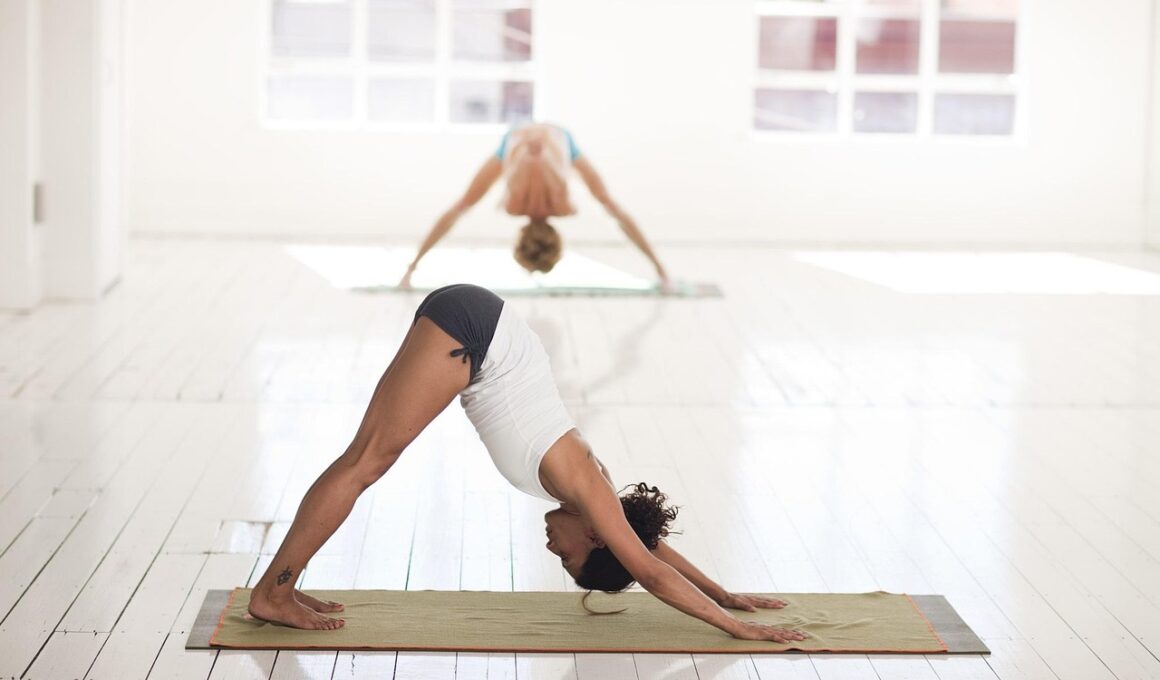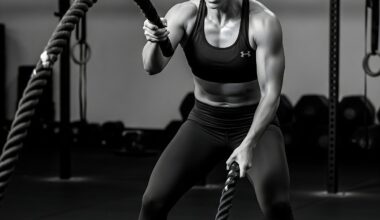How to Design a Bodyweight Flexibility Program at Home
Designing a bodyweight flexibility program can be an excellent addition to your fitness routine. Flexibility not only enhances overall performance but also helps prevent injuries during workouts. To start, consider your current flexibility levels and set realistic goals that aim to improve them. Consistency is key for achieving flexibility gains, so aim to dedicate at least a few minutes each session to stretching. Warm-up properly to prepare your body and enhance the effectiveness of your program. Dynamic stretches before your routine can promote blood circulation and improve your range of motion. Additionally, focusing on specific muscle groups that require more attention will help you achieve better results. Incorporate stretches for your legs, back, and shoulders, as they are crucial for overall body flexibility. Track your progress and adjust your routines as necessary to keep challenging your body. Ultimately, a structured and well-planned flexibility program can elevate your fitness experience and contribute to your overall health and wellness journey considerably.
One significant aspect of a bodyweight flexibility program is the variety of exercises included. To make your practice effective and engaging, ensure you incorporate multiple types of stretches. Dynamic stretches target ranges of motion actively, while static stretches help to hold a position for enhanced lengthening. Before each workout, perform a series of dynamic movements like leg swings, arm circles, or torso twists to loosen tight muscles. During your actual flexibility session, focus on static stretches for optimal lengthening. Consider incorporating yoga poses such as Downward Facing Dog or Pigeon Pose, as they provide significant flexibility benefits. Here are a few bodyweight exercises to consider:
- Forward Fold: This stretch targets your hamstrings and back.
- Cat-Cow Stretch: A dynamic stretch for spinal flexibility.
- Butterfly Stretch: Excellent for the inner thighs.
- Child’s Pose: Great for the lower back and shoulders.
These exercises can be performed easily at home without additional equipment.
Incorporating breathing techniques into your bodyweight flexibility program enhances the overall experience. Focus on inhaling deeply through your nose, allowing your abdomen to expand. Exhale slowly through your mouth as you release tension in your body. Synchronizing your breath with your movements promotes relaxation and helps you engage deeply within each stretch. Another effective approach during stretches is to visualize the muscles you’re targeting. Visualizing the muscle fibers lengthening can enhance your connection to them, thus maximizing efficiency. When transitioning between stretches, maintain a steady flow instead of rushing the movements. This approach not only improves flexibility but also allows the body to adapt to changes gradually. To create a nourishing environment for your practice, find a quiet place where you can concentrate. Soft, calming music or nature sounds can enhance the atmosphere, making your sessions enjoyable. Most importantly, listen to your body and respect its limits while pushing for improvements. Flexibility is a gradual process, so be patient and give your body time to adapt.
Creating a Schedule for Your Flexibility Routine
Establishing a dedicated schedule is crucial for the success of your bodyweight flexibility program. To begin, identify how many days a week you can realistically commit to stretching. Aim for consistency; practicing three to five times each week can yield significant results over time. Designate specific days for flexibility sessions in your weekly routine, and treat these sessions as non-negotiable appointments for your health. Consider varying the duration of your sessions: some may last just 15 minutes, while others can extend to 30 minutes, depending on your schedule. Setting aside more time during longer sessions allows you to incorporate additional stretches and focus on any tight areas. You might even find short daily stretches beneficial for warming up or cooling down after workouts. For longer sessions, engage in a variety of movements that target all key areas of the body. Consistent practice, scheduled appropriately, can reinforce your commitment to achieving greater flexibility and provide a sense of accomplishment as your abilities evolve.
To make the most of your flexibility training, incorporating balance and strength exercises in your routine enhances overall body control. Balance postures bolster stability while stretching, making your flexibility gains more effective. Integrate balancing movements like Tree Pose or Single-leg Balances in your warm-up or cool-down routines. Strengthening complementary muscles helps maintain joint stability, improving your overall flexibility progress. Consider combining light bodyweight strength exercises like squats and lunges focusing on form while adding flexibility at their peak range. When executing these movements, be mindful of your body’s alignment and avoid overextending, which could lead to injury. Retaining strength through bodyweight movements ensures that your flexibility remains functional and practical in real-life scenarios. As your flexibility progresses, you may notice enhanced athletic performance in activities like running, cycling, or even daily activities. The synergy between strength, balance, and flexibility allows you to become more agile overall. Embrace this holistic approach to fitness for greater adaptability and improved physical capabilities.
Tracking Your Progress
Monitoring your flexibility progress can boost motivation and guide your training in the right direction. Keep a journal documenting key exercises, durations, and personal observations during training sessions. Reflecting on your journey can reveal most successful techniques and highlight areas needing improvement. Consider using photos or videos to visually capture your progress at different intervals. Compare your movements over time to recognize your achievements. Smartphone apps also offer excellent tools for keeping track of flexibility workouts while providing structured routines and reminders. Setting short-term and long-term goals for flexibility can offer additional motivation. For instance, aim to achieve a specific stretch within a defined timeframe. Celebrate small milestones along the way to maintain enthusiasm and commitment. When you hit a significant goal, celebrate that success to reinforce your dedication to your overall flexibility journey. Familiarizing yourself with what works for you, combining all elements of flexibility training, can unlock significant improvements. Schedule regular assessments to gauge progress and adapt training as necessary to keep evolving. Consistency in tracking your journey can create a lasting and gratifying connection to your flexibility practice.
As you design your bodyweight flexibility program at home, maintaining motivation and interest is vital for success. Mixing up your routines can keep your practice fresh and enjoyable. Today, explore various stretching modalities like yoga, Pilates, or dance to maintain engagement. These activities provide unique approaches to flexibility while introducing new challenges. Participating in classes, online tutorials, or instructional videos can spark a sense of community, guiding you and sustaining your enthusiasm. Additionally, consider collaborating with a friend or family member to create an accountability system. Practicing together can add an element of fun and camaraderie to the process. Another effective strategy is setting themes for each session, focusing on different body areas or types of stretches. This thematic approach can transform ordinary practices into enjoyable experiences. Ultimately, your flexibility journey is a personal experience. Understanding and empowering yourself to make it exciting and enjoyable can propel progress forward. Embrace your unique path toward flexibility through bodyweight exercises while celebrating achievements along the way.
In conclusion, designing a bodyweight flexibility program at home can lead to significant physical improvements and overall wellness. Prioritize consistency in practice, combining dynamic and static stretches. Incorporate breathing techniques and visualizations to enrich your sessions. Creating a structured schedule will enhance your commitment, while adding balance exercises can improve overall abilities. Tracking your progress provides motivation and helps customize your routine further. Keeping your program engaging through variety, collaboration, and themes fosters a sustainable practice. Explore the incredible benefits of integrating flexibility into your fitness lifestyle and watch your progress evolve. Regardless of your current level, flexibility can be cultivated through consistent effort and dedication. Investing time in your body’s flexibility contributes to a healthier, more enjoyable life. No matter your goals—whether injury prevention, improved performance, or enhanced relaxation—bodyweight flexibility training has something to offer everyone. So, roll out your mat, set the atmosphere, and embark on this rewarding journey to flexibility right at home.


